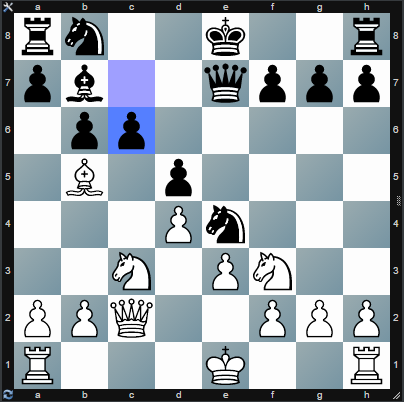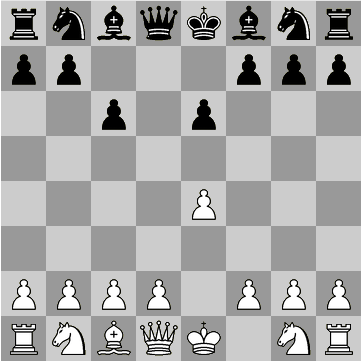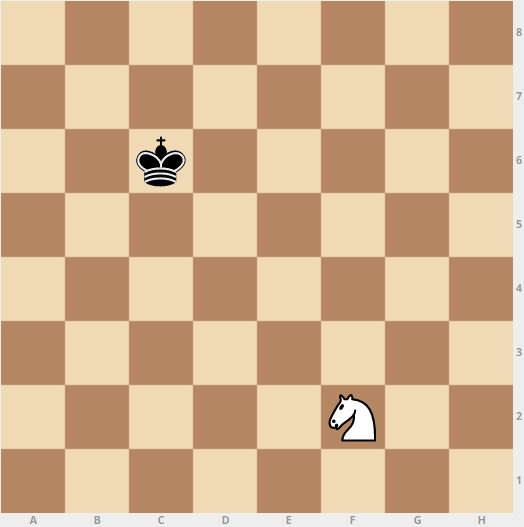Chess Puzzles
The field of chess puzzles is extremely diverse. It includes practical exercises to train one's skills at the game, compositions to illustrate beauty and fun/themed challenges, recreational puzzles such as retrograde analysis, and mathematical puzzles related to chess. Solving these puzzles is a special case of combinatorial games.
Practical Exercises
Practical exercises generally fall into one of two categories: tactics and analytics.
Tactics Puzzles
In tactics puzzles, a position is presented with a forcing line of play available, making the goal to find that variation. Solving such puzzles improves one's tactical vision, awareness, and pattern recognition.
When faced with such puzzles, the general strategy is to analyze the position as one would a real game, but the solver has an advantage in knowing that a tactical blow is present. It then becomes even more beneficial to organize one's calculations in the following order:
- First, the solver examines the moves available that put the opponent in check, because these moves are the most forcing (by limiting the opponent's replies).
- If nothing clear is found, the solver then examines the moves available that captures one of the opponent's pieces, because these moves are the next most forcing: if the opponent responds with a lackluster move, the puzzle is effectively solved as a winning position has usually been reached.
- If checks and captures are ineffective, the solver then examines the moves that set up an immediate threat. For example, a candidate move might be to move a piece in a way that threatens checkmate, since this also limits the opponent's reasonable replies.
It is rarely the case that the most accurate move in a tactical puzzle does not fall in one of the above categories.
Analytics Puzzles
Analytics puzzles are much more involved, asking the solver to come up with a positional plan for the next few moves. Endgames, in particular, often involve little calculation and more long-term planning. These puzzles are not as commonly seen, however, because they demand a relatively high level of skill to reasonably approach, and because their somewhat subjective nature can make a proposed plan hard to judge, they are not automatable.
 On the right is an example of a tactical puzzle, from the site chesstempo.com. Going through the above process reveals that checks are ineffective: the only available one is 1. Bxc6?, which is strongly met by 1... Bxc6, or even 1... Nxc6!? 2. Nxd5 Nb4! when Black simply has an extra piece.
On the right is an example of a tactical puzzle, from the site chesstempo.com. Going through the above process reveals that checks are ineffective: the only available one is 1. Bxc6?, which is strongly met by 1... Bxc6, or even 1... Nxc6!? 2. Nxd5 Nb4! when Black simply has an extra piece.
The next moves to consider are captures, revealing the solution: 1. Nxd5!
Black cannot recapture the knight with his pawn on c6, as the bishop on b5 would put him in check, and his queen is under attack. When his queen moves, White will also be able to capture the knight on e4, as it will no longer be defended by Black's queen. If Black tries to avoid this by playing 1... Qe6?, White wins the game by playing 2. Nc7 (check), attacking both the king and the queen simultaneously.
- Re7
- Qxc7
- Qf3
- Rxc8
In the position below, which is the strongest move for White?

 White to move. What is the minimum number of moves for white to checkmate the black king. Assume both sides play optimally. If a force mate is not possible, give your answer as \(0\).
White to move. What is the minimum number of moves for white to checkmate the black king. Assume both sides play optimally. If a force mate is not possible, give your answer as \(0\).
Composed by L-C. M. de La Bourdonnais, 1883
Compositions
In chess compositions, the goal remains to win (or draw in the face of heavy material deficit), but the positions are rarely ones that would feasibly occur in a practical game.
This is usually due to one of two reasons:
- The goal is constrained, so that rather than the goal being simply to reach a winning position, the goal may be to checkmate the opponent within a specified number of moves. This usually means the pieces are situated in extremely odd positions, which is highly unlikely to occur in practice.
- A basic tenet of composed problems is that the solution should be unique, meaning there is no other way to achieve the specified goal besides the intended solution. In order to achieve this, pieces are often added in seemingly illogical positions to block unintended solutions.
In fact, having an unnatural position and/or solution is generally considered to be a plus, as it mandates a type of thinking similar to, but somewhat different than, the type of thinking necessarily to play chess at a high level.
Chess compositions are taken quite seriously, and titles (including grandmaster) are awarded both for solving competitions and construction of problems. While solving compositions may have little practical value, in the sense that there are more efficient training methods available, it is generally considered to be highly enjoyable by top players. Furthermore, it exposes one to patterns they would not necessarily be exposed to through practical play, so practical benefits remain.

The puzzle on the right is the Steinitz Gambit, composed by Samuel Loyd, who is widely considered to be the best chess composer in history. White's goal is to checkmate the opponent in exactly three moves.
This composition is a particularly beautiful one, because the solution is extremely unexpected, and from a practical player's perspective the situation on the board is a complete mess. Straightforward attempts to checkmate the black king, such as 1. Rxf2 (a highly natural move to a practical player), fail to lead anywhere.
Instead, the incredible solution is 1. Ke2!!, allowing Black to promote his pawn to a queen with check. Incredibly, after 1... f1Q 2. Ke3!!, White has allowed Black to create a queen for no compensation, and yet Black is helpless to defend against the many checkmate threats.
In the position below, how can White give checkmate in two moves?

The target square of the first move can be represented as a coordinate \((x,y)\), where the bottom left corner square is at \((1,1)\). Input the product of \(x\) and \(y\) as your answer.
It is White's move. What must White play in order to mate in 3?

The bottom left corner square has coordinates \((1, 1)\). Each piece has a value: \(\text{Queen}=10\), \(\text{Rook}=5\), \(\text{Pawn}=1\) and \(\text{King}=4\).
Submit your answer as \(V\times { x }_{ 1 }\times { y }_{ 1 }\), where \(V\) denotes the value of the piece that White must move and the coordinates of the square where it has to go are \(\left( { x }_{ 1 },{ y }_{ 1 } \right) \).
Clarification: Black plays optimally.
This is the second problem of the set Mate
Recreational Puzzles
Another class of problems is similar to compositions, but the goal is not usually to discover the solution to a given position in the usual sense.
One type of these problems is retrograde analysis, in which a position and a number of moves is given, and the goal is to determine what sequence of moves produced the given position. Alternatively, a position may be given, with information (such as the last move) requested based on the knowledge that the position arose from a legal series of moves.

The goal here is to produce the position on the right, from the starting position, using exactly four moves for each side. For example, the natural attempt 1. e4 c6 2. Bc4 e6 3. Bxe6 dxe6 is not a correct solution, because both sides have only used three moves. This solution also poses a red herring, as attempts to "lose a move" during the execution of its process are not working.
Instead, the surprising solution is to abandon that concept entirely, and allow the d-pawn to be captured directly instead:
- e4 e6
- Bb5 Ke7
- Bxd7 c6
- Be8 Kxe8
Other classes of recreational problems:
- Construction problems, in which a certain goal (such as "deliver checkmate with the move Kxh1") is to be executed in the smallest possible number of moves. This number of moves is usually surprisingly low; for example, ending a game with "...exd1=N checkmate" takes just five moves, and the shortest possible stalemate can be performed in only 10.
- Helpmates, in which a position is given with Black to move, and both players cooperate to checkmate Black in a specified number of moves.
- Selfmates, in which a position is given with White to move, and White forces Black to checkmate him.
In the following position, the color of each piece is unknown (each piece could either be white or black), but it is known that the position arose from a series of legal moves, starting at the usual starting position.

Before the last move was made, Black had \(a\) pieces worth \(b\) points (on the scale Queen = 9, Rook = 5, Bishop = Knight = 3, Pawn = 1, King = 0). What is the product of \(a\) and \(b\)?

In our extraordinary game,
- Black has castled in the last move,
- In one of the 3 previous moves, the white knight from g1 was captured on its initial square.
Which piece captured the knight?
This problem is the second of the set Retrograde Chess.
Mathematical Puzzles
There are several types of mathematical puzzles involving chess, as the board and unique piece movements relate the game to graph theory in several different ways.
The most famous of these puzzles is the knight's tour, in which the goal is to find a sequence of knight moves that visits every square exactly one time, and returns to its original position. It has been shown that a knight's tour on a rectangular \(m \times n\) board exists unless one of the following three conditions holds:
- \(m\) and \(n\) are both odd
- \(m = 1, 2,\) or \(4\)
- \(m = 3\) and \(n = 4, 6,\) or \(8.\)
In particular, on an \(8 \times 8\) board, the knight's tour is possible -- in fact, there are over 26 trillion of them.
Another famous problem is the 8 queens problem, in which the goal is to place 8 queens on a chessboard so that no two attack each other. This is also a classic introductory problem in computer science, reaching such fame that 92 (the number of ways to place the queens) is known in many circles (especially competitive programming) as the "8 queens constant". This problem can be generalized to a larger class of independence problems, in which the goal is to place pieces on the board such that none attack each other, and dominance problems, in which the goal is to place pieces on the board such that every square is attacked. Interestingly, 5 queens is sufficient to achieve dominance on an 8x8 board.
Consider a \(8 \times 8 \) grid. Several of the tiles have tokens on them and there can only be one token on any tile. Call any tile "brilliant" if there exists an adjacent tile with a token on it.
What is the minimum number of tokens needed so that all tiles of the chessboard are brilliant?
Note: 2 tiles are adjacent if they share a common side. Tiles that only share a common corner are not considered adjacent.
 On a typical 8 x 8 chess board, what is the most amount of queens can be placed on a chess board, where the opponent has not been checkmated?
On a typical 8 x 8 chess board, what is the most amount of queens can be placed on a chess board, where the opponent has not been checkmated?
Note: Only one king on the board with the opponent only having queens.
What is the most number of white rooks that can be placed on a chessboard in such a way that a black king, also placed on the board, is not under attack?
The king may be placed anywhere on the \(8\times 8\) board.

Bonus: Generalize it for an \(m\times n\) chessboard.
More traditional math problems are also possible on chessboards, as the piece movement and structured nature of the board is very useful in combinatorics problems.
A rook begins at a corner of an \(8 \times 8\) chessboard. Every minute, it makes a legal move, where each move has the same probability of being chosen. What is the expected number of minutes before the rook reaches the opposite corner?
Source: 2015 HMMT November Team Round, Problem 8.

Dimitri places a Black King and a White Knight on 2 distinct squares in an empty chessboard. If the probability that Dimitri places the King and the Knight on the chessboard such that the King is not in check (that is, the Knight is not attacking the Black King), can be expressed as \(\dfrac{m}{n}\), where \(m\) and \(n\) are coprime positive integers, find \(m+n\).
As an explicit example, if the Knight is on \(\text{f2}\), the \(\text{h3}\), \(\text{d3}\), \(\text{d1}\), \(\text{h1}\), \(\text{g4}\) and \(\text{e4}\) squares are under attack.
This problem is the second of the set Look after the King!.

What move can white make and not mate in one?
Now, to convert your answer to a number:
Let \(C_1\) be the column you are moving from and \(R_1\) be the row you are moving from. And, let \(C_2\) be the column you are moving to and \(R_2\) be the row you are moving to. (Rows 1-8 and columns 1-8) Finally, concatenate your answer as \(C_1\)\(R_1\)\(C_2\)\(R_2\)
For example, if you were to take black's pawn with your rook, you'd put your answer as 7675.
This is not an original problem. I believe the original author was Karl Fabel.
Maximum puzzles

What is the maximum number of queens you can place on a \(8\times8\) chessboard such that none of them can attack each other in one move?